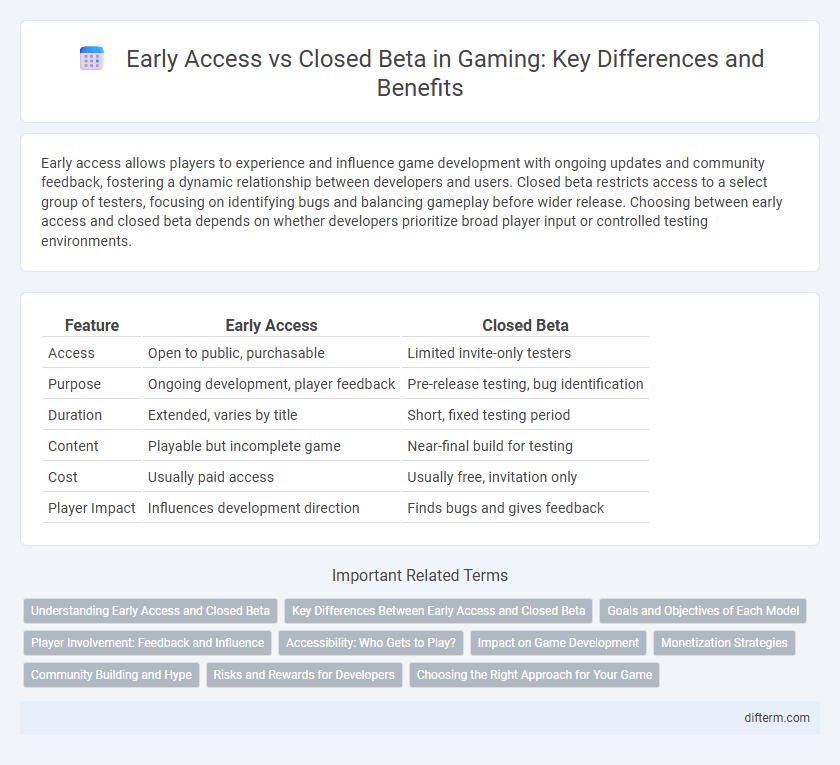Early access allows players to experience and influence game development with ongoing updates and community feedback, fostering a dynamic relationship between developers and users. Closed beta restricts access to a select group of testers, focusing on identifying bugs and balancing gameplay before wider release. Choosing between early access and closed beta depends on whether developers prioritize broad player input or controlled testing environments.
Table of Comparison
| Feature | Early Access | Closed Beta |
|---|---|---|
| Access | Open to public, purchasable | Limited invite-only testers |
| Purpose | Ongoing development, player feedback | Pre-release testing, bug identification |
| Duration | Extended, varies by title | Short, fixed testing period |
| Content | Playable but incomplete game | Near-final build for testing |
| Cost | Usually paid access | Usually free, invitation only |
| Player Impact | Influences development direction | Finds bugs and gives feedback |
Understanding Early Access and Closed Beta
Early Access provides gamers with the opportunity to play and support a game during its development phase, offering feedback that can influence final features and content. Closed Beta grants a limited group of players exclusive access to test game mechanics, identify bugs, and help developers refine gameplay before a wider release. Both phases are crucial for balancing game performance and player experience, but Early Access tends to be more open and community-driven compared to the controlled and focused testing environment of Closed Beta.
Key Differences Between Early Access and Closed Beta
Early Access grants players full, extended gameplay access with ongoing updates and monetization, allowing developers to gather comprehensive feedback while generating revenue, whereas Closed Beta offers limited, invitation-only testing focused on identifying bugs and balancing issues before official release. Early Access communities often influence content development over months, while Closed Beta is time-limited and highly controlled to refine core game mechanics. Monetization and widespread player involvement distinguish Early Access from the restrictive, feedback-centric nature of Closed Beta testing phases.
Goals and Objectives of Each Model
Early access aims to gather extensive user feedback to refine gameplay mechanics and address bugs while generating revenue through early sales. Closed beta focuses on controlled testing with a limited player base to evaluate server stability, balance game features, and fix critical issues before broader release. Both models prioritize improving user experience but differ in scale and the stage of development targeted for testing.
Player Involvement: Feedback and Influence
Early access allows a broader player base to actively participate in the game's development by providing real-time feedback, leading to iterative improvements and bug fixes. Closed beta involves a select group of testers who offer focused insights, enabling developers to refine core mechanics and balance gameplay before wider release. Player involvement in early access often results in a more community-driven evolution, whereas closed beta feedback is typically more controlled and targeted.
Accessibility: Who Gets to Play?
Early access offers broader accessibility, allowing a wide range of players to experience the game before full release, often through purchase or subscription, while closed beta restricts participation to a select group invited for testing, typically based on applications or specific criteria. This limited access in closed beta aims to gather targeted feedback and identify critical bugs from a controlled audience, ensuring a more stable launch. Early access players contribute to ongoing development through diverse feedback but may encounter more unfinished features and bugs compared to closed beta testers.
Impact on Game Development
Early access allows developers to gather real-time player feedback during ongoing development, enabling iterative improvements and timely bug fixes. Closed beta testing offers a controlled environment with selected participants, providing focused insights on game balance and server stability before broader release. Both stages contribute crucial data that shapes gameplay mechanics and overall user experience, optimizing game quality prior to full launch.
Monetization Strategies
Early access games typically implement monetization through initial purchase fees, in-game microtransactions, and seasonal battle passes to generate continuous revenue during development phases. Closed beta testing often restricts monetization to limited in-game purchases or premium access, focusing more on collecting player feedback and refining gameplay mechanics without fully launching revenue streams. Developers leverage early access for iterative content updates and player-driven monetization, while closed beta prioritizes controlled testing environments with minimal financial incentives.
Community Building and Hype
Early access allows a broader player base to engage with the game, fostering organic community building and sustained hype through continuous feedback and updates. Closed beta targets a select group of dedicated testers, creating an exclusive atmosphere that generates anticipation while refining gameplay based on focused input. Both approaches strategically leverage player involvement to enhance game development and community loyalty.
Risks and Rewards for Developers
Early access offers developers the advantage of ongoing revenue and real-time player feedback, enabling iterative improvements but risks exposing unfinished content that may harm the game's reputation. Closed beta provides a controlled environment to identify critical bugs and balance issues with a limited, engaged audience, reducing public scrutiny but delaying broader community feedback. Balancing early access and closed beta phases can optimize development by mitigating risks of negative publicity while maximizing rewards from player-driven enhancements.
Choosing the Right Approach for Your Game
Choosing the right approach between early access and closed beta depends on your game's development stage and player feedback goals. Early access offers broader exposure, generating revenue while gathering wide-ranging player data, which is ideal for ongoing content refinement. Closed beta provides targeted feedback from a select group of testers, crucial for identifying critical bugs and balancing issues before a full release.
early access vs closed beta Infographic

 difterm.com
difterm.com